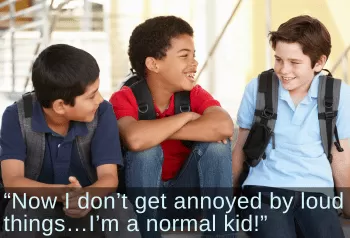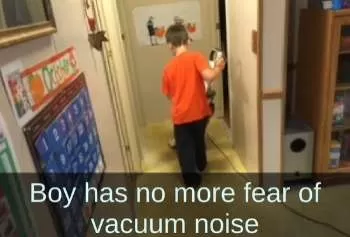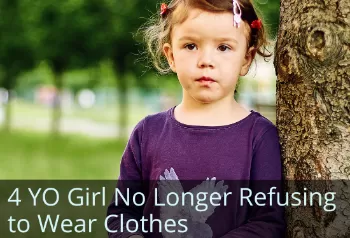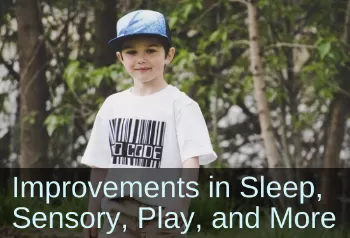Sensory Processing Disorders (SPD)
Are Sensory Disorders Connected to Retained Primitive Reflexes?
by Sonia Story, M.S.
Though we may learn about sensory integration and reflex integration separately, in reality, there is no way to separate the sensory system from the reflex and motor systems. They work together in a holistic way. In human development infant reflexes are immensely important to establishing optimal sensory processing.
Each infant reflex is a distinct motor pattern in response to specific sensory input. Reflexes and sensory processing systems respond to one another and depend on one another for optimal maturation. They are intertwined in our development and there is no way to separate the two. Infant reflex integration and sensory processing are holistic, dynamic, and interdependent systems. So we can use one system to affect the other.
As Dr. Blomberg taught, in order to have mature sensory processing, the primitive and postural reflexes must be integrated also. Research shows that immature primitive reflexes are strongly associated with sensory disorders (Pecuch et al., 2020).
For nearly all children with challenges, their sensory systems are out of balance. Sensory issues go hand-in-hand with lack of maturity of the primitive reflexes. So if you hear about or observe "sensory issues," it is safe to assume: "Primitive reflexes could use work!"
By working to integrate reflexes, we are automatically maturing the brain, body, and sensory systems—for deep and lasting change.
In the Brain and Sensory Foundations course we learn more about why this is and how these innate movements provide the optimal foundation for sensory processing. Because any reflex can impact the sensory systems, it is helpful to have an in-depth, comprehensive reflex integration program. Here are 6 Essentials for Choosing a Primitive Reflex Integration course.
The case studies here show the transformative power of innate rhythmic and reflex integration movements to help overcome sensory issues.
This little girl struggled with sleep issues, hypersensitivity, anxiety, and meltdowns. See how innate movements made a life-changing difference!
This little boy could not tolerate the sound of a vacuum, and refused to go into public restroom because of the sound of the hand dryers. Rhythmic movements and primitive reflex integration have eased his fear of the hand dryers and he is now also able to run the vacuum himself!
Clothing sensitivities brought this little girl to her OT, who used rhythmic movements and primitive reflex integration to mature her nervous system. Read how these tools helped resolve these issues so she is now willing to wear a wider variety of clothing, even non-preferred items such as underwear.

Classroom sounds and activity were overwhelming for this boy, who rarely interacted with his fellow students, always wore his hooded winter coat indoors, and often hid under a table. See how, after practicing rhythmic movements and primitive reflex integration, he is no longer wearing his winter coat and he's beginning to interact with his classmates.
When a Sensory Diet Is Not Enough
After years of working with children using innate rhythmic movements and reflexes, I took a course on primitive reflexes from the wonderful Mary Kawar, a veteran OT, well known for developing vestibular and sensory integration programs.
As she told us stories about the children she worked with, Mary Kawar said (paraphrased): "I have a very comprehensive vestibular program, and a very comprehensive sensory integration program. And many of the children I see are showing me they really need reflex integration." She recommended using innate rhythmic movements and reflex integration to help children overcome their challenges.
I had come to the exact same conclusion from my own experience. Many parents, OTs, PTs, educators, and colleagues confirm this idea. One therapist wrote:
"I have learned that all of the sensory processing activities in the world will not result in significant gains if there are gaps in [primitive] reflex integration."Occupational Therapist
This mom's journey with her son is likely to surprise you! See her 5 minute video testimonial on how using innate rhythmic and reflex movements created huge improvements in sensory processing in just three days!
Extreme noise sensitivity made it so this little boy could not stand to be anywhere crowded or with a lot of background noise. See how rhythmic movements and primitive reflex integration improved many of his sensory issues.
This young woman reported freezing in response to loud noises, as well as social anxiety that hindered her ability to participate in group settings. Find out how rhythmic movements and integrating her Moro reflex helped ease her anxiety in social situations and prepare for an upcoming mission trip.
Parents and therapists find that they make the most progress with sensory issues—and so much more—when they focus on rhythmic movements and reflex integration as a first priority.
Reference
Pecuch, A., Gieysztor, E., Telenga, M., Wolańska, E., Kowal, M., & Paprocka-Borowicz, M. (2020). Primitive reflex activity in relation to the sensory profile in healthy preschool children. International Journal of Environmental Research and Public Health, 17(21).
Sonia Story, M.S. has been teaching neurodevelopmental movements since 2006.
Sonia developed the Brain and Sensory Foundations program to provide comprehensive training in neurodevelopmental movements—combining innate rhythmic movements, play, primitive reflexes, and postural reflexes.
She earned a Bachelor's degree in biology/psychology and a Master’s degree in Movement Sciences. She is the author of The Importance of Reflex Integration and the Evidence eBook, giving the rationale and evidence basis for using neurodevelopmental movements for helping with challenges such as ADHD, Sensory Processing Disorders, anxiety, emotional dysregulation, visual skill deficits, poor social skills, gross and fine motor delays and other neurodevelopmental and behavioral disorders.
Her work is featured in numerous podcasts, summits, and conferences, and in the books Almost Autism: Recovering Children from Sensory Processing Disorder; Special Ed Mom Survival Guide; Family Health Revolution; and Same Journey, Different Paths—Stories of Auditory Processing Disorder.
Sonia’s mission is to help children and families experience the profound benefits of neurodevelopmental and integrative movements for more functional and fulfilling lives.







